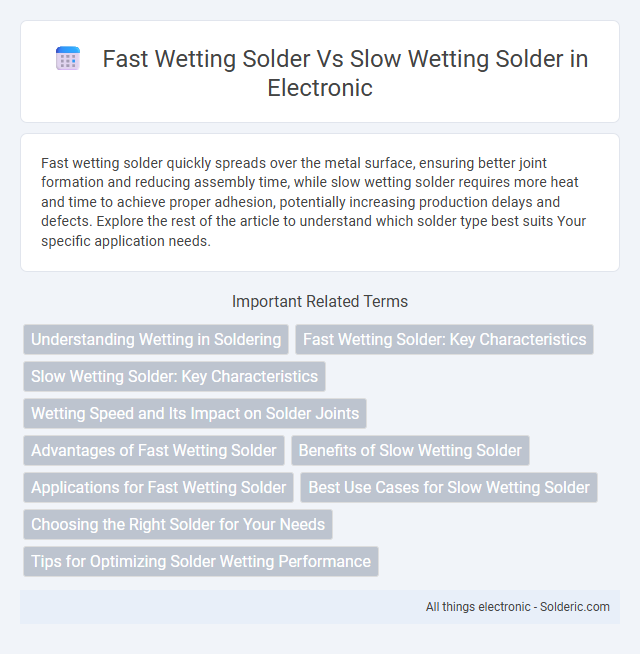Fast wetting solder quickly spreads over the metal surface, ensuring better joint formation and reducing assembly time, while slow wetting solder requires more heat and time to achieve proper adhesion, potentially increasing production delays and defects. Explore the rest of the article to understand which solder type best suits Your specific application needs.
Comparison Table
| Feature | Fast Wetting Solder | Slow Wetting Solder |
|---|---|---|
| Wetting Time | Short, rapid spread on substrate | Longer, delayed spread |
| Application Speed | High throughput manufacturing | Lower production speed |
| Joint Quality | Consistent, strong joints | Potential for incomplete bonding |
| Oxide Removal | Efficient oxide dissolution | Poor oxide removal, requires flux |
| Suitability | Mass production, SMT assembly | Prototyping, specialized applications |
| Cost | Typically higher-priced alloys | Generally lower-cost options |
Understanding Wetting in Soldering
Wetting in soldering refers to the ability of molten solder to spread and adhere to metal surfaces, which is crucial for forming strong, reliable joints. Fast wetting solder quickly creates a uniform bond by reducing surface tension and enhancing alloy interaction with substrate materials like copper or nickel. Slow wetting solder often results from impurities or oxidation, leading to weak joints and increased risk of electrical failures in electronic assemblies.
Fast Wetting Solder: Key Characteristics
Fast wetting solder exhibits rapid surface tension reduction, enabling quicker and more consistent spread over metal substrates. Its enhanced flux activity and lower melting temperature contribute to improved joint reliability and reduced heating time during assembly. These properties make fast wetting solder ideal for high-speed manufacturing processes and delicate electronic components.
Slow Wetting Solder: Key Characteristics
Slow wetting solder exhibits a longer time to fully adhere to the substrate, resulting in extended solder joint formation during the assembly process. This type of solder often displays higher surface tension and reduced fluidity, which can challenge the wetting of difficult or oxidized surfaces. Your choice of slow wetting solder may be influenced by specific application requirements where controlled flow and precise solder placement are critical.
Wetting Speed and Its Impact on Solder Joints
Fast wetting solder quickly spreads over the substrate, creating strong, reliable joints and reducing production time in electronics manufacturing. Slow wetting solder can lead to incomplete coverage, increasing the risk of weak joints and potential failure under thermal or mechanical stress. Your choice of solder wetting speed directly impacts the overall quality and durability of the electronic assembly.
Advantages of Fast Wetting Solder
Fast wetting solder significantly reduces soldering time, enhancing manufacturing throughput and efficiency in electronics assembly. Its superior ability to quickly spread and bond with metal surfaces improves joint reliability and minimizes defects such as solder bridges and cold joints. This rapid wetting characteristic leads to better thermal and electrical conductivity, essential for high-performance electronic components.
Benefits of Slow Wetting Solder
Slow wetting solder offers improved control during the soldering process, reducing the risk of bridging and defects in complex or fine-pitch components. It allows for better heat distribution, minimizing thermal stress on sensitive electronic parts and enhancing joint reliability. This controlled wetting behavior is particularly beneficial in precision applications where solder flow must be carefully managed to ensure consistent and high-quality connections.
Applications for Fast Wetting Solder
Fast wetting solder is ideal for high-volume electronics manufacturing where rapid solder joint formation is critical to maintaining production efficiency and minimizing defects. It is commonly used in surface mount technology (SMT) for consumer electronics, automotive electronics, and telecommunications equipment to ensure strong, reliable connections on complex printed circuit boards (PCBs). Fast wetting solders improve throughput in automated assembly lines by reducing soldering time while enhancing joint quality and consistency.
Best Use Cases for Slow Wetting Solder
Slow wetting solder is ideal for complex or delicate electronics where controlled heat distribution is crucial to prevent damage. Your applications involving sensitive components, such as multi-layer PCB assemblies or fine-pitch components, benefit from the precision and reduced risk of thermal shock offered by slow wetting solders. This type also enhances joint reliability in scenarios requiring gradual alloy formation and improved mechanical strength.
Choosing the Right Solder for Your Needs
Fast wetting solder quickly adheres to surfaces, providing strong, reliable joints ideal for high-speed production environments or sensitive components requiring minimal heat exposure. Slow wetting solder allows more time for precise placement and adjustment, making it suitable for intricate or delicate assemblies where control is critical. Your choice between fast and slow wetting solder should align with the complexity of the task, component sensitivity, and desired production speed to ensure optimal results.
Tips for Optimizing Solder Wetting Performance
Optimizing solder wetting performance involves selecting the appropriate solder alloy and flux formulation to match your application requirements, with fast wetting solder typically enhancing joint quality by reducing oxidation and improving flow characteristics. Controlling temperature profiles during the soldering process ensures optimal wetting behavior, where too high or low temperatures can hinder solder spread. Maintaining clean surfaces and proper soldering techniques will maximize adhesion and minimize defects, ensuring your solder joints are strong and reliable.
fast wetting solder vs slow wetting solder Infographic

 solderic.com
solderic.com